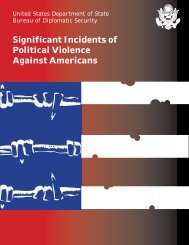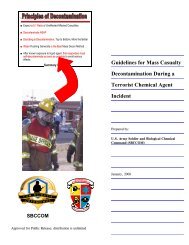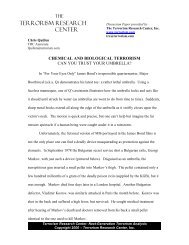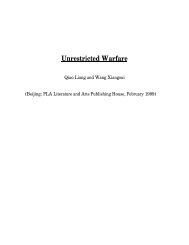Combating Proliferation of Weapons of Mass Destruction
Combating Proliferation of Weapons of Mass Destruction
Combating Proliferation of Weapons of Mass Destruction
You also want an ePaper? Increase the reach of your titles
YUMPU automatically turns print PDFs into web optimized ePapers that Google loves.
Presidential Decision Directive (PDD) series was created to promulgate presidentialdecisions on national security matters. PRDs and PDDs are usually, though not always,classified.Notwithstanding the policy-making framework established by the National Security Act <strong>of</strong>1947, as amended, contemporary presidents, including President Clinton, have preferredless formal means for receiving advice. The NSC rarely, if ever, meets as a corporate body.Instead, President Clinton consults his “foreign policy team,” an informal group whosemembership varies according to the issues under discussion, but which generally parallelsthe NSC. The President began this practice several years ago, after receiving criticism inthe press and in Congress for lack <strong>of</strong> attention to national security affairs. For some time,the President met with his “foreign policy team” every two weeks. It is unclear with whatregularity the practice continues. This illustrates, however, one <strong>of</strong> the great strengths <strong>of</strong> theNational Security Act, from a President’s perspective: it allows him to manage nationalsecurity affairs according to his decision-making style, while providing a broad legalframework for the process <strong>of</strong> policy development and implementation.Assistant to the President for National Security AffairsContrary to popular perception, the National Security Act <strong>of</strong> 1947 did not create theposition <strong>of</strong> Assistant to the President for National Security Affairs. President Eisenhowerestablished the position in 1953 with the appointment <strong>of</strong> Robert Cutler. Although theprecise title <strong>of</strong> the incumbent has varied, the position has come to be known as thePresident’s National Security Advisor. Under Eisenhower, Cutler (and each <strong>of</strong> his threesuccessors) served as the principal executive <strong>of</strong>ficer <strong>of</strong> the NSC, setting the agenda,briefing the President, and supervising the staff. Based in part on the military staff system,the Special Assistant to the President for National Security Affairs facilitated the decisionmakingprocess, but had no substantive role and did not function as a policy advocate.The role <strong>of</strong> the National Security Advisor, like the NSC, has evolved considerably in theensuing years. To a great extent, it has been a function <strong>of</strong> the operating style <strong>of</strong> thePresident, as well as the personality <strong>of</strong> the incumbent National Security Advisor. (SeeReport <strong>of</strong> the President’s Special Review Board, February 26, 1987, p. II-2 and 3, for adiscussion <strong>of</strong> the functions <strong>of</strong> the National Security Advisor.)In the Clinton Administration, the National Security Advisor’s involvement in proliferationrelatedmatters is similar to his role in other substantive areas. He is the “honest broker”for the NSC process, assuring that issues and options developed by the NSC PrincipalsCommittee are clearly presented to the President and that all relevant views are accuratelyconveyed. He is a confidential and independent advisor to the President. He monitorsimplementation <strong>of</strong> the President’s national security policies. He develops policy initiatives.He keeps the President informed about foreign developments and activities both inCongress and in the departments and agencies that affect the President’s national security2







